#gathlain
Explore tagged Tumblr posts
Text
Prestige Class Spotlight 14: Daivrat

The relationship between mortals and genie-kind is sometimes quite tense, and often imbalanced, with one ruling over the other, whether it be by physical might or magic. Few places is this more true than Qadira and the greater Kelesh Empire, there powerful conjurers mastered the art of binding genies to their service. Many wonders and structures across the empire owe their creation to genie labor or wishcraft, and many such genies remain in servitude even now, waiting as only an immortal can for the day when the culture changes and they and their kin will be freed, either to go on their merry way, or to exact their revenge.
But not every spellcaster in the land is a genie binder, nor do they necessarily view the elemental beings as potential or current slaves. Indeed, the Daivrat, a word that roughly translates as “genie-friend”, are quite the opposite, viewing genies as equals, trusted advisors, and comrades.
Such mages offer to help the lot of genie-kind, be they slave or free, and can expect to gain willing favors from such beings in kind, even from the most vicious and domineering varieties.
While none would choose to control genies as their counterparts would, daivrats are in a position to bargain fairly with genies that they either encounter or call upon with magic, and if there’s anyone that a genie would look for loopholes in their contract for or offer wishes genuinely without twisting them, it would be to a daivrat that has proven true and good as their word.
So let’s take a look at them!
The requirements for this prestige class include third-tier magic, focus on conjuration, and a greater mastery of certain lore (thereby making in available at around the same time for both full and mid casters), as well as knowledge of the four elemental languages and peaceful contact with a genie, making this a decent option for most casters outside of minor ones.
Naturally, they also progress with their mastery of their magic for all but the first level.
Each daivrat also specializes in either an element or elemental damage type, making appropriate spells harder to resist. Naturally, this later improves.
With their reputation and familiarity with genie customs, these mages are quite adept at both identifying and endearing themselves to genies of all stripes.
These mages gain the service of minor incorporeal genies they can call upon to retrieve spell information during their daily preparations, giving them access to a spell they would not normally have access to, even from outside their normal spell list or casting tradition. However, the unfamiliarity of these spells means they require greater magical energy to cast, less so if it was a spell that they could theoretically have learned on their own.
Their reputation with genies also bolsters them when they summon or call genies, making summons last longer and it easier to bargain with them.
They also gain a ward against an elemental damage type from their study of the elements.
Powerful daivrats earn the service of a lesser zhyen genie, which serves as their familiar.
The most powerful of these mages become so infused with elemental energies that they become partially genie-like themselves, gaining elemental resistances and a tougher body.
If you want to play a mage that works with genies, but really don’t want to deal with the controlling aspects of being a genie binder, this prestige class may be for you. Gaining buffs to the DCs of your favorite element, as well as being able to get an extra spell from any source each day is fun, as is the elemental resistances. However, the core of the class is in the buffs they gain to diplomacy and negotiation with genies, so only consider this prestige class if you know the game will have lots of opportunities to interact with them. Additionally, consider how different classes interact here. Divine casters might be even friendlier with genies due to having planar ally instead of planar binding, while a more martial caster might use the class to add spells beyond their combat-focused list to their arsenal each day, as well as fight alongside genies and elementals directly. Also, if you’re not also diving into the genie binder, consider picking up the summon genie spells from People of the Sands.
The flavor of this prestige class implies that the character is at least on good terms with genies, and that lends itself to a lot of good story beats like genies, including efreeti, asking the character for aid. As a GM, you should consider how to fit such things into the story, and also when they would be disruptive to the plot you are trying to tell.
Ever since learning of the existence of planes beyond the material and fey realms, Kersta of Bloomwood has been eager to learn as much about these new friends as possible, which led to her studying conjuration magic and later the art of befriending elementals and genies. For their part, most genies are amused by the flighty and adorable gathlain, and are usually willing to aid her.
One normally doesn’t think of genies when thinking of Bolgara Marsh, but rumor has it that it was once host to great elemental power. Finding these sunken ruins won’t be easy, but if the native vodyanoy are treated respectfully, they might be convinced to show the way. Supposedly, the ruins might hold secrets regarding the lost elemental planes of metal, wood, and possibly even stranger elements as well.
A grand theft of the Sultan’s vault has the court up in arms, for the stolen treasure contained a bound efreet malik. Whatever the plans the thief has will surely pale in comparison to the revenge the powerful genie would wreck if set free. As such, the royal mages are of two minds about the whole thing. The binders naturally want to recapture and renew the wards on the genie to control him anew, while the daivrats naturally wish to try and placate the fire spirit and set him free to his long-neglected home on the elemental maelstrom.
6 notes
·
View notes
Text
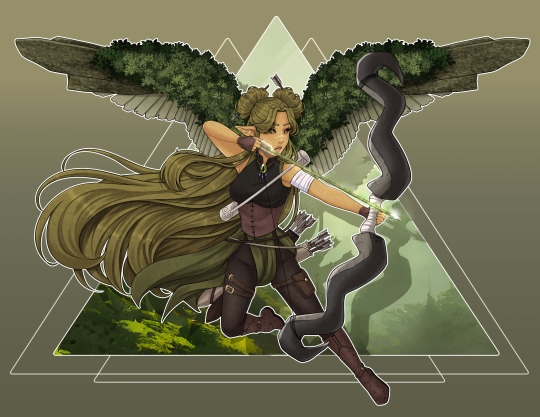




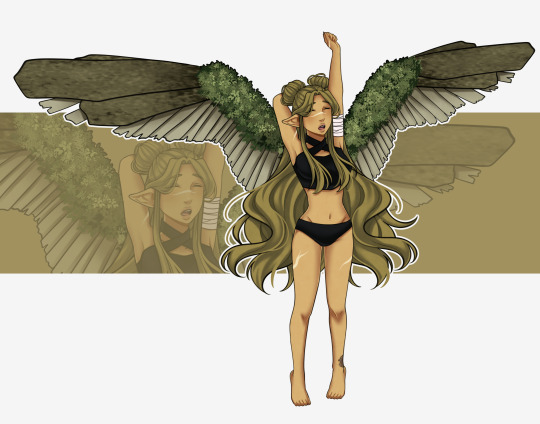
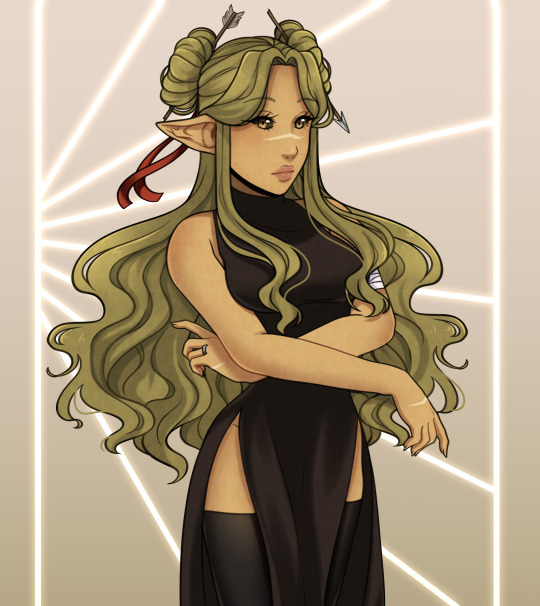

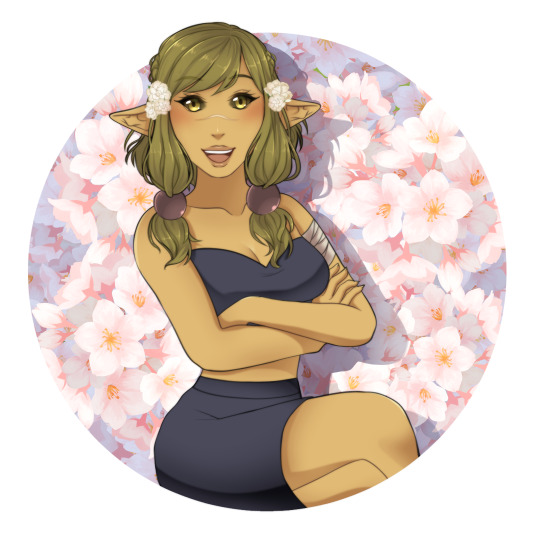
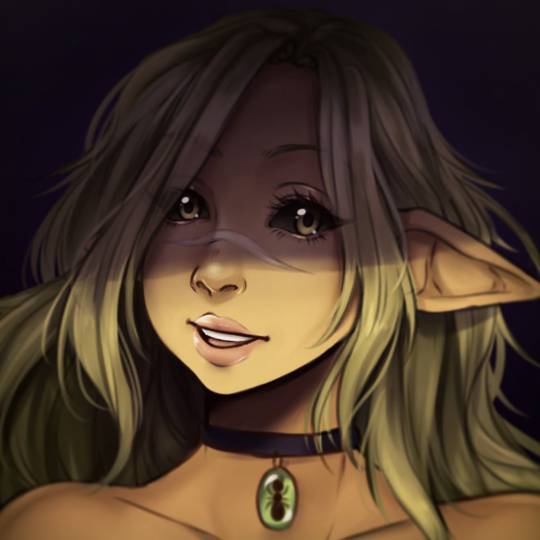
Much older art below

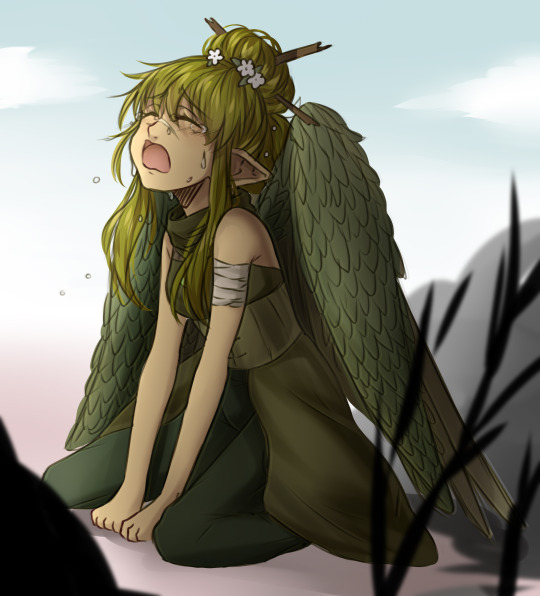

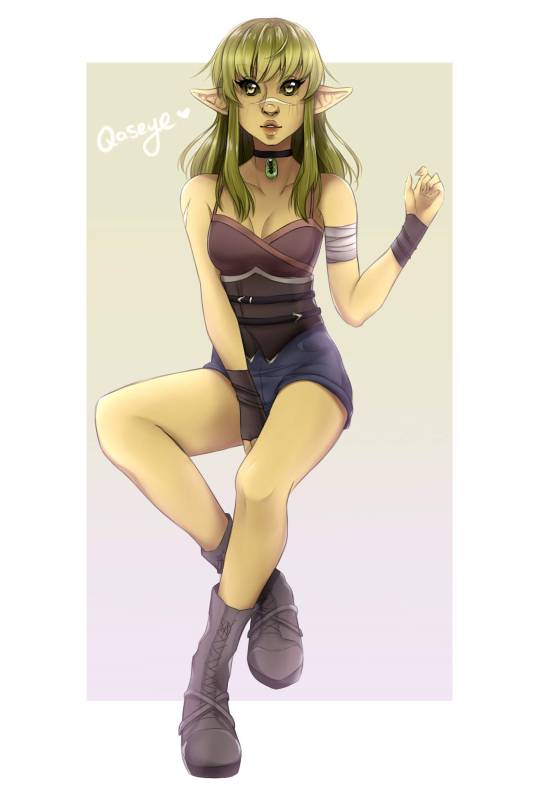



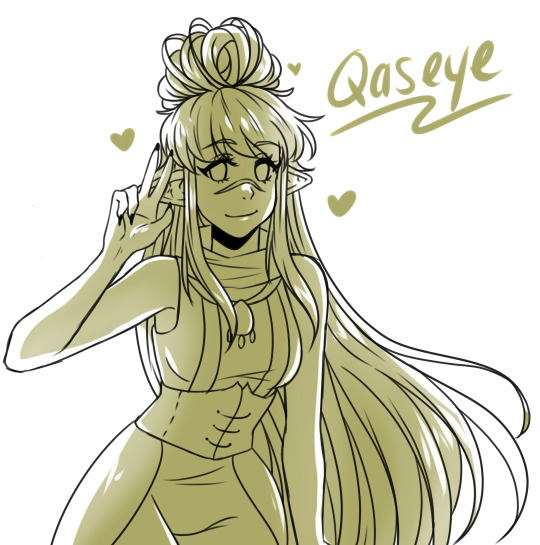
Qaseye is my Gathlain Hunter, she's a Pathfinder character from my EOA campaign :3c The timeline of this art is gonna be completely whack SO
20 notes
·
View notes
Text
it's funny how 5e and 3.x bards just feel completely different to me, and at least as far as 3.5/pf1e, im actually much more of a fan of 5e's execution of the class (very rare, that. im a big, BIG fan of pf1e's particular brand of jank) and there isn't really any equivalent bc 5e's bards are completely busted (affectionate) and good at everything.
so if i were to make Adran/Adana in pf1e, it would have to be some sort of gestalt
currently, im toying with a gestalt of sworn of the eldest inquisitor (perhaps unknown wood elf father had some gathlain blood in him!) // seeker oracle of the whimsy mystery, with the haunted curse.
Full caster (if divine) with a more supporty/debuff-y spell list + skillsy bastard who gets to add charisma to an awful, awful lot of those skills. and fey flavored is almost the same as bard flavored.
2 notes
·
View notes
Text
My apologies, in advance, for going on a bit of a rant here.
Drake Companion is, without a doubt, one of the worst offenders out of the 'non-animal companion' feats. You just get a weird-looking lizard for most of the campaign, and it despises you.
Then there's the feat whose name I can't even be bothered to remember from Cohorts & Companions. It's basically just Leadership but worse. You get a cohort, and it has to be a magical beast. Also, no followers.
Now, here's where it gets interesting. Craft Construct is part of the core rules, and is one of the most well-known and straightforward ways of gaining a non-animal minion. But there are also two feats that riff off of this one, those being Grow Plant Creature (also from Cohorts & Companions) and Craft Ooze (from Alchemy Manual).
Grow Plant Creature is far from perfect, but it does its job. Using rules similar to those for growing leshies, the feat allows a PC of sufficient skill to grow plant creatures. Exactly what it says on the tin. The plants possess no inherent loyalty to their creator, but are also inclined to hear them out. So, you can use Diplomacy on intelligent plants like treants. But what about plants of animal-like Intelligence? Not to worry, this feat has the Train Plants feat, introduced in the same book, as a prerequisite. Which, again, does exactly what it says on the tin, and allows PCs to use Handle Animal on plants.
Craft Ooze, on the other hand, is a real mixed bag. With Craft Construct, you need to pay for materials and spend countless hours labouring away, and you need to be a powerful spellcaster, but you gain a devoted and often fairly powerful (or at least somewhat useful) construct servant. With Grow Plant Creature, you gain a potential ally, provided you're a good owner (is the ownership of a sapient plant slavery? This is never addressed. As an aside, it's worth noting that the ownership of creatures like pseudodragons, who are good, and griffons, who are neutral, is explicitly called out in their flavour text as slavery. But hieracosphinxes, who are evil, are given rules for training and riding, and there is no 'this is slavery' disclaimer. Is the idea that evil creatures deserve to be enslaved? Interesting to think about...). With Craft Ooze, you spend thousands of gold pieces on a massive vat, then spend days brewing a squishy little buddy... that's mindless, has no affinity for you, and is basically just a living weapon. Why the fuck would I take this feat? It's basically just the Alchemist's Bottled Ooze discovery, but worse! Even intelligent oozes made this way are mindless (and bottled intelligent oozes aren't, which is fucked up, since they melt into ash soon after birth, which can't be pleasant), so what's the point of making an intelligent ooze? Does an apallie made this way turn into a non-sapient humanoid during the night? That would be so disturbing! Anyway, all that to say, I'd rule that this feat allows you to make some sort of alchemist's equivalent of wild empathy (or maybe just straight-up wild empathy) on oozes. If that's a bit much, then maybe only your created oozes. Also, let the intelligent oozes retain their Intelligence scores, dammit! If the intelligent constructs and plants can, why not the oozes? What have you got against the Goop Troop?
Ahem. Moving on.
One of the better feats (if only marginally) is Monstrous Mount from Inner Sea Combat, which somewhat understood the assignment. You get animal companion-style stats for a few magical beasts. But you can't fly until later. Because your mount can't carry you. It's not strong enough yet. Like, okay, sure, I guess that makes sense. Still feels like a cop-out. Paizo... you do realize you ALREADY gave PCs the ability to fly at 1st level, right? You've got at least four flying races (and unlike 2e, they don't have to go through a fucking feat chain to fly). We've got the gathlain, the strix, the syrinx, the wyvaran. Hell, even tengu can glide with an alternate racial trait. If you really want to avoid flight being game-breaking, give the mount clumsy or poor maneuverability that improves with time. It's worth noting that a dire bat companion starts out as Medium, and thus can be ridden by a Small character. It has a fly speed of 40 ft. (good). Precedent is there, in the very first Bestiary! Just because it's not an animal, a vermin, or a plant, doesn't mean it's inherently overpowered. A hippogriff is just a horse with wings and a beak! Why the fuck would I want one if I can't fly?! Then it's just an ugly horse!
I'm terribly sorry, the more I think about this, the more pissed off I get.
I plan to (eventually, when I get around to it) homebrew my own version of the Monstrous Mount feat, mixing it with Drake Companion. Taking the best parts of both, adding my own fixes, and discarding all the bullshit. Craft Ooze's bullshit aspects are pretty simple to just ignore, and Grow Plant Creature is more or less alright as is, so I won't do my own takes on those, though I probably will come up with prices, DCs, and durations for monsters not covered in the feat's examples. I mean, I've already got a document in the works determining prices for animals, magical beasts, and various other creatures not covered in Animal Archive or Ultimate Equipment, so I'll probably include those there. I might even cover some of your homebrew creatures. I intend to be thorough. It will be painful, going through every single Bestiary, every single module, every single AP, every single Campaign Setting, every single Player Companion, and for what? 5 notes? Ah, well. Also, I'm planning to add synergy between the Technologist and Craft Construct feats. We've had canonical NPCs who can tinker with Numerian robots. High time we give the PCs a taste!
TL;DR
I'm homebrewing a feat that'll allow any PC with mount, hunter's bond, divine bond, or nature bond to have a magical beast, aberration, or dragon as their 'animal' companion, with scaling advancements far more frequently than animal companions. I'll try to make it balanced, but no promises.
Also, I'm homebrewing rules for ooze and plant creation (specifically for the species not covered in the respective feat's entries), as well as prices for almost every low to mid-CR Material Plane and First World creature in the game, and rules for creating and repairing/modifying robots using Craft Construct and Technologist.
Odogaron

Image © Capcom, accessed at Monster Hunter Wiki here
[Commissioned by @werebear95. Odogaron appears to be a fan favorite among the MH fanbase–it has lots of fanart, and I’ve seen it in memes. There’s also an idea that it’s somehow friendly, and lots of the fanart involves odogaron pets or mounts. Pathfinder is not a system that handles pets of all creature types super robustly. I feel like the need to make all animals suitable for animal companions is what makes PF1e’s animals boring, and the various feats and archetypes to make other creature types into companions are typically unbalanced or un-fun, and mutually exclusive to each other. Take the Drake Companion feat, which kind of sucks. The drake doesn’t get Large until 15th level and actively resents the PC. If you want an odogaron as a pet, my advice is to build an eidolon to look like it, or take an animal companion and describe it as an odogaron with your GM’s help (a tiger or allosaur would be a pretty good match, given its pounce-heavy fighting style)]
Odogaron CR 12 CN Dragon This reptilian beast moves swiftly on all fours, its legs ending in paws with two layers of scythe-like claws. Red scales cover its entire body, except along the tail, which is grayish in color and covered in bony studs. Its head is long and lean, bearing oversized canine teeth.
An odogaron is an apex predator of rocky hills and valleys. They hunt through speed and strength, making hit and run attacks and leaving deep bleeding wounds with their multiple layers of claws. They are intelligent enough only to be capricious, and true dragons view them with pity tinged with disgust. That doesn’t prevent those great beasts from having to be wary in odogaron territory—an odogaron prides itself on its strength, and often goes out of its way to challenge powerful predators to either kill them or force them to submit.
An odogaron behaves more like a wild beast than a mighty dragon, but they do have one frightening supernatural skill. They can overclock their metabolisms, pushing them to extreme acts of speed and giving off so much extra heat they sear creatures with a touch. Doing so exhausts an odogaron after a few rounds, and so the monsters typically attempt to fight normally for a while and enter their blazing frenzy only if it looks like they are losing a confrontation. Odogarons do not like to retreat from combat, and do so only grudgingly.
Ebony Odogaron
Larger, stronger and even more vicious than the usual odogarons are the ebony odogarons. They are blue-black in color instead of red, and smoke pours from their mouths when they are in combat. An ebony odogaron is an odogaron with the advanced simple template. Any creature bitten by an ebony odogaron must succeed a DC 25 Fortitude save or become exhausted. An ebony odogaron is a CR 13 monster.
Keep reading
#pathfinder 1e#pathfinder#pathfinder homebrew#game design#bullshit game design#creature companions#craft construct feat#technologist feat#homebrew feat#craft ooze feat#grow plant creature feat#plant#ooze#dragon#magical beast#construct#robot#animal#train plants feat#cohorts and companions#alchemy manual#drake companion feat#monstrous mount feat#feats#go home paizo you're drunk
93 notes
·
View notes
Text
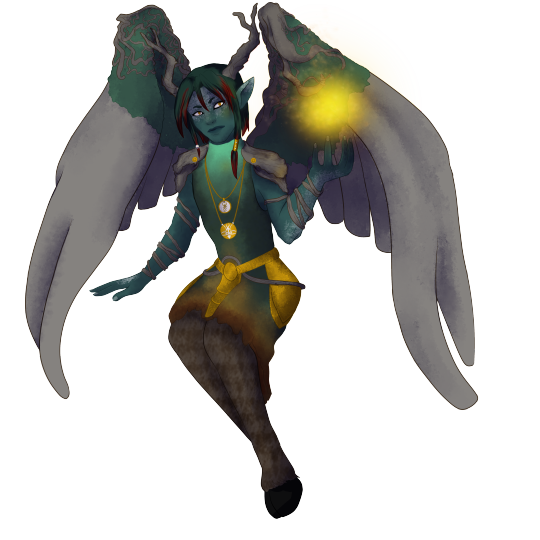

Have art of my Warpriest, Kri'ah. We stream the game every other Wednesday on twitch (on foxydoodle). Friend's twitch, not mine. ^^
10 notes
·
View notes
Text

Another commission finished! This baby girl is a Pathfinder character named Zyvian, and she’s a mistletoe tree Gathlain with a Fennec Fox familiar
Like what you see? Check out my Commissions!
5 notes
·
View notes
Photo

I FINALLY FINISHED IT
So this is the Pathfinder party I used to be a part of! I’ve had this in the works for like two years or something silly, and I’ve left the group now (so didn’t bother drawing my character), but it seemed a waste to not do anything with this since it was like 90% finished lol
But yeah sorry for my inactivity but here’s some art! (ノ◕ヮ◕)ノ*✲゚*。⋆
#pathfinder#d&d#dungeons and dragons#rpg#rpg party#d&d party#half-orc#half-elf#dwarf#gathlain#copic#marker#promarker#traditional art#fantasy#art#I'm gonna miss these guys ;v;
14 notes
·
View notes
Photo
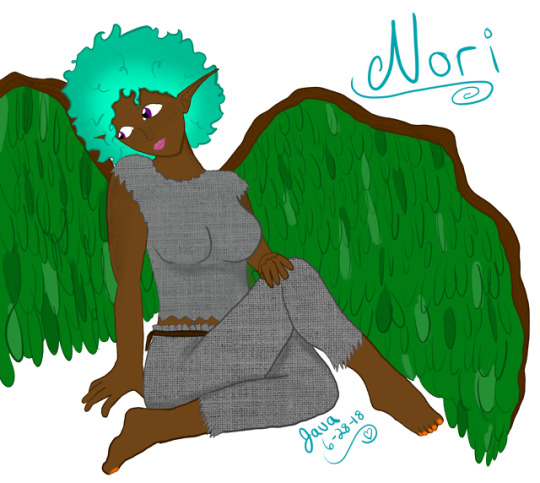
A D&D character of mine. She’s a Gathlain Bard. Gathlain are a race of fey creatures from the Feywild that are basically plant based fey. This campaign was kinda crazy while it lasted. The Shadow Plane, The Feywild and The Material Plane had all sort of overlapped. No known reason why it just did. So they were trying to figure out how to coexist and you could just walk between the planes. Her name is Nori and she’s adorable.
2 notes
·
View notes
Text
Fey Prankster (Rogue Archetype)

(art by Bianca Dirmina on Artstation)
From one fey prankster to another, this is yet another archetype with heavy connections to the Gathlain. However, anyone with a bit of fey magic might consider taking this archetype.
Today’s flavor of prankster is considerably less magical, and less a professional comedian or jester. Instead, they are sneaky trickster types, ne’er-do-wells that use a combination of mundane trickery and magical deceptions to befuddle others.
Some may do this to teach lessons to fools and villains, while others might seek personal thrills. In this way, they seem to invoke the classic idea of the trickster hero, using their wits and deception to win the day, whether they are truly heroic or not.
Obviously, gathlains and gnomes are a natural pick for this archetype, but anyone with a connection to the fey, be it a mingling of blood, having been taught by the fair folk, or even living among them for a time, picking up their tricks and becoming a bit more than mortal in the process.
In any case, their skills are manifold and their pranks devious.
Whether it is animating a vine or root just long enough to grasp a target or just making the bushes rustle, these tricksters can use nearby plant life to distract foes to either sneak away or create openings in their guard.
Naturally, they also learn how to fight dirty as a matter of course.
One of their signature tricks is using illusions to swap the appearances of two objects or people, leading to all sorts of confusion and mischief. Later on, they can even swap their locations as they swap appearances, useful for thievery, heists, and much, much more.
They also can use their plant-animating powers to lay sneaky traps, tripping, debilitating, or even ensnaring foes.
Finally, these sneaks seem to blend into surrounding plant life, even if it normally wouldn’t cover their form.
Being able to take advantage of nearby plants and getting free dirty trick feats is quite useful, but where this archetype really shines is in the setup. The ability to trade the appearances of objects of people can be quite useful for stealing something without anyone knowing, or sneaking into somewhere where they ought not be, or tricking foes who think they are talking to or attacking someone else. The ability to rig nearby foliage into simple traps is also powerful, if niche, since it’s only really useful if you have time to prepare the battlefield. You lose out on trapfinding, uncanny dodge, and a handful of rogue talents for this archetype, but if it suits your character idea, go for it!
Much like yesterday, who you decide to trick is up to your discretion, but discretion is probably worth employing regardless. That being said, these characters, being rogues, are likely to use their skills for practical purposes first, to aid in their skullduggery.
Most would consider the morlocks a lost cause, the last shreds of a people driven to degeneracy by their isolation underground. However, the morlocks of Algan’s Delve have gained a new patron, a fey Eldest of the underground and gemstones, that has been teaching them secrets of magic (albeit slowly). Now, some of them are employing these tricks against their hostile neighbors, though the archfey’s motives are yet unknown.
The suspicious already assume that the nagaji practice deceptive “snake magic”, but the powers that Ikshada wields come from no naga. The sneak thief cares not if others exotify and vilify her for her magic. She just steals from them regardless, teaching a lesson against their arrogance. However, most don’t seem to learn, if the bounty on her head is any indicator.
The King’s gala was a disaster. Guests and guards shrouded by illusions, a duchess claiming that a plant attacked her, AND to top it all off, the crown jewels have been replaced by a handful of rocks! There is now an immediate bounty put out on the perpetrator, but can the party find them before they vanish back into the Fey Realms?
25 notes
·
View notes
Text

Small WIP from last night c:
Old design Qaseye melts my heart
5 notes
·
View notes
Photo
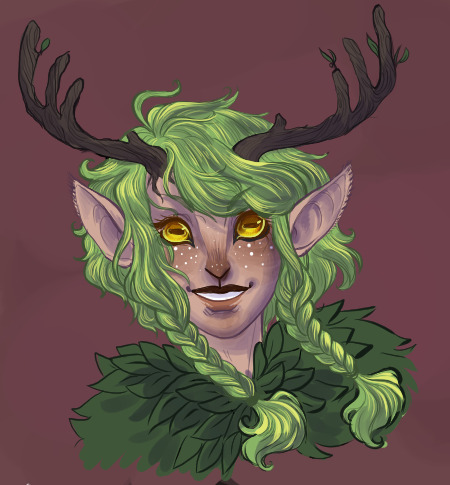
i’m dming pathfinder’s reign of winter for my family, but since they’re only 3 players and none of them particularly wanted to play a healer, i made a healbot npc to travel with them and make sure they don’t die
so, they needed a token! this is ailbhe, they’re an oracle with the divine herbalist archetype and the winter mystery, they speak in 3rd person and are probably the most annoying person on the planet. but, they’re fey, so that probably goes without saying.
15 notes
·
View notes
Photo
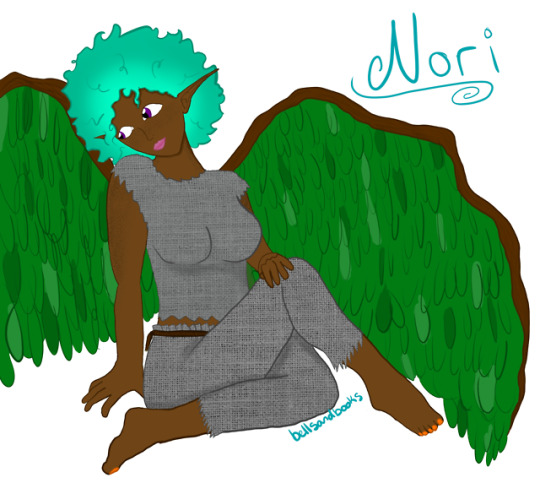
So, this took way longer than I usually spend on drawings but I think it was totally worth it. This is Nori. My Gathlain Bard for my group’s upcoming campaign. Our first step into 5e. I’m super excited to play her.
She’s formerly a dancer in a travelling fey caravan in the feywild. The outfit is because the characters are starting off in jail. I will absolutely do one of her much more commonly worn clothing items sometime.
Nori is very small and full of mischief. She stands at 2 feet 8 inches tall. Teal hair (natural!) and violet eyes. Her wings are wooden with leaves draping below them similar to a weeping willow. Usually she favors bright, vibrant colors. Reds and blues and greens- all of them. Sometimes all of them at once.
1 note
·
View note
Text

My Pathfinder character, Wyr'asa. Gathlain ossuarite druid turned ranger. Not pictured is his companion, Bone Dog (who despite the name is no longer bones)
12 notes
·
View notes
Text
Forest Temple Keeper - CR4 Fey Shaman
A Gathlain NPC based on Saria from Ocarina of Time.
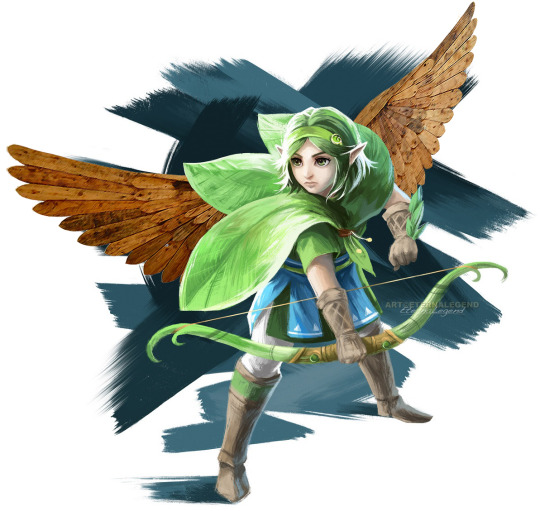
Artwork by Jasqreate on DeviantArt and Rachel Kiernan at WordPress, ineptly combined by me.
Gathlain always seemed a lot like Kokiri to me, just with wings. They’re forest fey who look like children their whole lives, and even grow from seeds that fall from a great tree. The concept behind this NPC is a gathlain who serves as the guardian of a nature temple deep in the forest. The NPC isn’t particularly combat-adept, but its ability to fly helps it find cover in the trees, and it is friends with many of the woodland animals and fey creatures in the surrounding forest.
Those forest creatures are likely to come to the forest temple keeper’s aid in battle, and will need to if you intend to use it as an enemy encounter. The forest temple keeper’s ability to speak with trees might inform it when creatures have entered the forest or temple, giving it a chance at a surprise round. It uses smoke bullets, thunderstones, tanglefoot bags, and support spells to disable enemies and buff allies. Without help, this creature and its familiar are more like CR 3. It’s perhaps better suited as a friendly NPC who guides the players and can heal them if needed.
This NPC has an improved familiar, a sprite with a couple of tiny wands. Aside from yelling “Hey! Listen!” and “Watch out!”, the sprite flies around the battlefield and attempts to use the wands to heal allies or trip enemies. Keep in mind that its reach is so bad that it has to share a space with someone in order to heal them, and it only has a 40% chance of successfully using either wand. It tries to heal allies if it can do so without entering melee; otherwise it uses the wand of Stumble Gap.
The forest temple keeper has Tailwind pre-cast on its entire party (including its familiar), pointed in whatever direction makes it easier for them to get away from enemies. This NPC gains proficiency with longbows from a trait, which it buys off with the Lonely drawback.
I’ve included the text of relevant class abilities, leaving out a few useless ones.
If you want to support this blog, now there’s an easy way to do so through my Ko-Fi page! https://ko-fi.com/lockez
Forest Temple Keeper - CR 4
The young-looking green-haired child watching over the temple entrance is clad in the leaves of the forest, and a small glowing fairy buzzes around her. Her wooden wings must be what she used to reach the high tree branch she’s sitting on, from which she’s aiming an arrow down at you.
XP 1,200 Gathlain shaman 5 CG Small fey Init +3 Senses low-light vision; Perception +5
DEFENSE
AC 18, touch 17, flat-footed 12 (+5 Dex, +1 dodge, +1 natural, +1 size) hp 26 (5d8) Fort +1, Ref +4, Will +9; -2 vs. charm
OFFENSE
Speed 20 ft., fly 30 ft. (poor) Melee unarmed +0 (1d2–2) Ranged longbow +8 (1d6/x3 plus thistle arrows) or sling +7 touch (smoke bullets) Special Attacks monstrous insight, swamp’s grasp
Shaman Spells Prepared (CL 5th; concentration +9) 3rd—blindness/deafness (DC 17), tailwind 2nd—wood shape, summon nature’s ally II, forest friend 1st—entangle (DC 15), entangle (DC 15), bless, hide from animals (DC 15), sleep (DC 15) 0th—create water, detect magic, know direction, mending
Spontaneous Shaman Spellcasting (CL 5th; concentration +9) 3rd (1/day)—locate object, minor creation (wood only) 2nd (1/day)—barkskin, tongues 1st (1/day)—identify, shellelagh
Spell-like Abilities (CL 5th, concentration +5) 1/day—speak with plants (trees only)
STATISTICS
Str 7, Dex 16, Con 11, Int 10, Wis 18, Cha 10 Base Atk +3; CMB +0; CMD 13 Feats Improved Familiar (sprite), Small But Deadly, Weapon Focus (longbow) Traits Heirloom Weapon (longbow, weapon proficiency), Lonely Skills Fly +5, Handle Animal +4, Heal +8, Linguistics +1, Knowledge (nature) +8, Knowledge (religion) +4, Survival +11, Perception +5 (+3 to see through disguises) (+7 when familiar is within arm’s reach), Sense Motive +3 (+5 when familiar is within arm’s reach), Spellcraft +4, Use Magic Device +5 Languages Celestial, Common, Sylvan SQ spirit (wood), wandering spirit (lore), tree dialect, whispering leaves Gear small longbow, small sling, thistle arrows x30, smoke bullets x10, thunderstone x3, tanglefoot bag x3, hooded lantern, small +1 spellsink chainmail
SPECIAL ABILITIES
Thistle Arrows (Ex) A forest temple keeper fires thistle arrows from its longbow. These arrows deal normal damage but then become embedded in the wound and deal an additional 1 point of damage each round for 1d6 rounds from their irritating sap. Creatures immune to poison are immune to this extra damage. A creature can remove an embedded thistle arrow as a move action without provoking attacks of opportunity, but doing so deals an additional 1d3 points of damage as the thorny barbs are pulled free. A DC 12 Heal check (made as a standard action) can pull free a thistle arrow’s head without dealing any additional damage.
Smoke Bullets (Ex) A forest temple keeper fires smoke bullets from its sling. Smoke bullets require only a successful touch attack to release the smoke. When they strike a target, they burst, releasing a cloud of noxious gas that requires the creature struck to attempt a DC 13 Fortitude save. If the save fails, the target is nauseated for 2 rounds.
Spellsink Chainmail (Su) A forest temple keeper wears a magical suit of spellsink chainmail. A suit of armor or a shield with this ability can absorb and neutralize magical effects, albeit on a limited basis. Once per day as an immediate action, the forest temple keeper can command the armor to absorb a magical ability created by a magic item, a spell, or a spell-like ability that specifically targets only the forest temple keeper. The armor cannot absorb spells, spell-like abilities, or item effects that target an area or multiple targets. The attacker creating the magical effect to be absorbed must succeed at a DC 14 Will saving throw or the armor absorbs and neutralizes the effect.
Monstrous Insight (Su) Three times per day, a forest temple keeper can identify a creature and gain insight into its strengths and weaknesses. As a standard action, the forest temple keeper can attempt a Knowledge skill check to identify a creature and its abilities (using the appropriate skill for the monster’s type) with a +5 insight bonus. Whether or not the check is successful, the forest temple keeper also gains a +2 insight bonus for 1 minute on attack rolls made against that creature and a +2 insight bonus to AC against attacks made by that creature. These bonuses last for 1 minute.
Swamp’s Grasp (Su) As a standard action, a forest temple keeper can summon an entangling quagmire to fill an area. Five 10-foot squares within 90 feet become difficult terrain for 7 rounds. If the shaman uses this hex again before the duration of the previous use has expired, the effects of the previous use of this hex end immediately.
Whispering Leaves (Su) Whenever the forest temple keeper is within 10 feet of a tree or undergrowth, it can cast Whispering Wind as a spell-like ability (caster level 5). The targeted area must also contain trees or undergrowth, which relay the message in a gentle, rustling voice.
Forest Temple Guardian’s Sprite Spirit Familiar
CN Diminutive fey Init +3 Senses detect evil, detect good, low-light vision; Perception +6
DEFENSE
AC 20, touch 17, flat-footed 17 (+3 Dex, +3 natural, +4 size) hp 13 (5d6) (half of master’s hp) Fort +1, Ref +5, Will +4 DR 2/cold iron Defensive Abilities improved evasion
OFFENSE
Speed 15 ft., fly 60 ft. (perfect) Melee shortsword +3 (1d2-4/19-20) Ranged shortbow +10 (1d2-4) Space 1 ft.; Reach 0 ft.
Spell-Like Abilities (CL 5th; concentration +5) Constant—detect evil, detect good At will—dancing lights, daze (DC 10) 1/day—color spray (DC 11)
STATISTICS
Str 3, Dex 17, Con 10, Int 8, Wis 11, Cha 10 Base Atk +5; CMB +4; CMD 10 Feats Alertness Skills Escape Artist +15, Fly +21, Handle Animal +1, Heal +1, Knowledge (nature) +7, Knowledge (religion) +0, Linguistics +0, Perception +6, Sense Motive +2, Stealth +19, Swim +0, Use Magic Device +8 Languages Auran, Common, Sylvan SQ luminous Gear diminutive wand of cure light wounds (30 charges), diminutive wand of stumble gap (13 charges)
SPECIAL ABILITIES
Luminous (Su) A sprite naturally sheds light equal to that provided by a torch. A sprite can control the color and intensity of the light as a swift action, reducing it to the dimness of a candle or even extinguishing its luminosity entirely if it wishes.
Spirit Animal Camoflauge (Su) The forest temple guardian’s sprite spirit familiar looks like a wooden figurine or a vaguely fairy-shaped tree branch when it is motionless. The spirit familiar gains freeze as per the universal monster rule. The spirit familiar can take 20 on its Stealth check to hide in plain sight as this kind of inanimate object.
Improved Evasion (Ex) When subjected to an attack that normally allows a Reflex saving throw for half damage, a familiar takes no damage if it makes a successful saving throw and half damage even if the saving throw fails.
Familiar Alertness (Ex) While its spirit familiar is within arm’s reach, the forest temple guardian gains the Alertness feat.
Empathic Link (Ex) The forest temple guardian has an empathic link with its spirit familiar to a 1 mile distance. The master can communicate empathically with the familiar, but cannot see through its eyes. Because of the link’s limited nature, only general emotions can be shared. The master has the same connection to an item or place that his familiar does.
Speak with Master (Ex) When the forest temple guardian and its spirit familiar communicate verbally, they can choose to do in such a way that other creatures do not understand the communication without magical help.
4 notes
·
View notes
Text
Helloooooo. Recently I drew this artwork of my Pathfinder OC Merli. She is a rather cocky, but gentle Gathlain, a tree soul or in German Baummystiker. She loves her teammates dearly, although she is teasing them a lot. She received a rainbow rose from a cleric of Shelyn once and now it's one of her treasures.

2 notes
·
View notes
Text
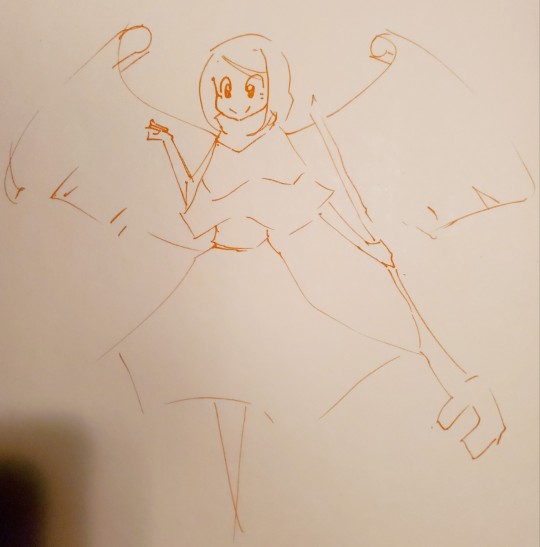
I'm working on a gathlain character. She has birch bark wings and is gonna have a moth swarm.
4 notes
·
View notes